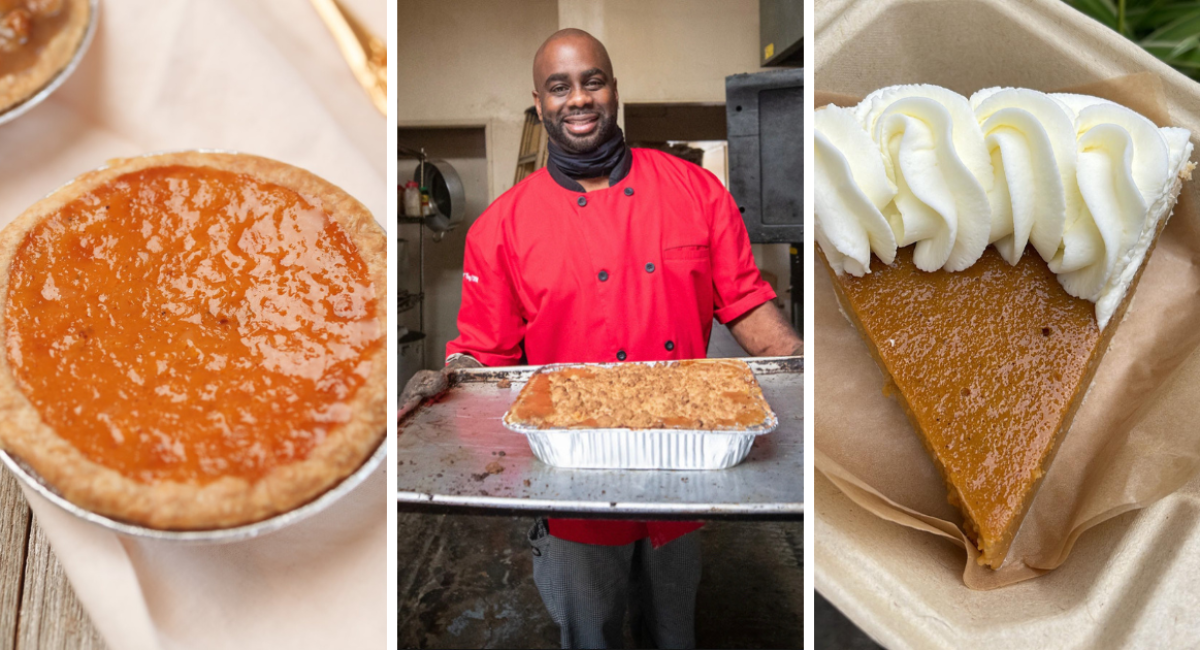In the fall of 2015, singer James Wright uploaded a video to Facebook eating a sweet potato pie made by music legend Patti Labelle’s Good Life food brand. The rest is the stuff of urban legends, as millions of views on the video translated to thousands of pies being sold nationwide. By Thanksgiving, it was harder to get a “Patti Pie” than it was to get a discounted Black Friday TV.
By the end of 2015, Patti Labelle had cemented herself as the Queen of Pies. But this cultural phenomenon wasn’t just about Patti. It brought national attention to a beloved American dessert present on holiday tables of Black households across the country. This is the story of how sweet potatoes went from a starchy vegetable to the main ingredient in one of the most recognizable desserts in America.



Origin of Sweet Potatoes: A Native American Food Journey
The sweet potato pie is an enduring and nostalgic dessert for most Black Americans. But do you really know the history and origin of its main ingredient, the sweet potato? Experts trace sweet potatoes back to Central America, where they were harvested by Native Americans and indigenous populations for centuries.
After the 16th century, and with increased colonization of Native American lands, the sweet potato was harvested by enslaved Africans brought to the Americas through the Transatlantic Slave Trade. The sweet potato’s close resemblance to yams (a topic we will discuss later) meant enslaved Africans had familiarity with growing that type of starchy vegetable and used it in meals. Eventually, sweet potatoes were a staple in the South and beyond as Black Americans migrated to the North and West. It also remains widely used by indigenous populations in Central and South America in recipes that often combine rice and unique combinations of rice to produce delicious sweet potato meals full of flavor.
Sweet Potato Variation
Today, there are numerous variations of sweet potatoes to choose from for your pies, or other popular recipes such as sweet potato fries, baked or roasted sweet potatoes, or candied sweet potatoes. Below are the varieties of sweet potatoes most commonly found in sweet potato pie recipes.
Beauregard: Beauregard sweet potatoes are one of the most popular types in the United States. They have reddish-purple skin and vibrant orange flesh. They are known for their sweet flavor and versatility in cooking, making them ideal for pies, fries, and mashes.
Garnet: Garnet sweet potatoes have dark red skin and orange flesh. They have a slightly sweeter taste than some other varieties and work well in pies, casseroles, and as a side dish.
Jewel: Jewel sweet potatoes have copper-colored skin and orange flesh. They are also sweet and are often used in both savory and sweet dishes. They are particularly well-suited for roasting.
These are just the top three sweet potatoes used for pies. There are actually over ten types of sweet potatoes, including some with purple skin. When shopping for sweet potatoes pay close attention to the type of sweet potato you are buying, especially if you will be using them for a pie or other sweet treats.
Sweet Potatoes and Yams: Doppelganger Crops
By now you may be wondering, “Wait, am I eating yams or sweet potatoes?” That is because these two crops are commonly used interchangeably, especially among Black Americans. Yet their agricultural origins are distinctly different and unique. Yams are traced back to West Africa, or the Gold Coast. The geographic connection to the Transatlantic Slave Trade often resulted in many people using sweet potato (native to Central America) and Yams (native to West Africa) as mere synonyms.
However, while sweet potatoes and yams are similar in food type (tubers), nutritional composition, and ways they are cooked; sweet potatoes and yams differ beyond geographic origins. They are not a part of the same botanical family; sweet potatoes belong to the morning glory plant family and yams have their own namesake plant family. Also, yams, especially those imported from West Africa or the Caribbean are starchier, drier, and more neutral in flavor. Yams often have white flesh and are used in cooking to bring out the flavors of other foods in the dish. Sweet potatoes are sweeter than yams and come in orange, yellow, white, and even purple flesh.
So those candied yams you are eating for Thanksgiving are most likely sweet potatoes, not yams. Today, even food packaging and grocery store signs use yams to describe sweet potatoes and often use Cassava to describe actual yams. So pay close attention so you don’t grab cassava instead of sweet potatoes.
Now we know most yams we eat are really sweet potatoes and the rise of sweet potatoes is a story about Black reinvention. But that is not where the story stops. It is believed sweet potato pie was born in the South by the way so many other Soul Food items came to be – through Black food ingenuity. Despite insidious living conditions, sweet potato pie’s presence represents food as resistance and substance. Rich in nutritional value, and full of flavor, the sweet potato pie is a complete and filling dessert, perfect in fall and winter.
After sweet potato pie was born in the South, it traveled as Black people migrated North and West for better opportunities. Over the decades, the sweet potato pie on the holiday dinner table is a reminder of family, of shared history, and of always finding ways to make and eat delicious food.
Sweet Potato Pie Variation
Today, there is no loss of sweet potato pie variations. Some variations switch the types of sweet potatoes being used or combine different types of sweet potatoes to make special blends. Other variations focus on sweetness and tartness, raising the sweetness with sugar and milk, or increasing the tartness with spices. Once you have mastered your sweet potato pie recipe, you may want to experiment with adding nuts such as pecans or walnuts, tartness in the form of coconuts or gingersnaps, or dial up the sweet factor with a marshmallow top layer. Also, as diets change, we now have non-dairy, Vegan, and gluten-free alternatives. As long as you can eat sweet potatoes, there is a pie for you.
STRIB’ble Treats – Greenbelt, Maryland
Georgia’s Sweet Potato Pie Company – Louisville, Kentucky
The Kobbler King – Los Angeles, California
Mixed Fillings Pie Shop – Jacksonville, Florida
Sweet Stuffed LLC – Little Rock, Arkansas
JaWanda’s Sweet Potato Pies – Birmingham, Alabama
The story of the sweet potato pie is a story of how food can persevere, despite its circumstances, and leave a yummy legacy. Originally harvested by Native Americans, Black people used their agricultural knowledge to not only harvest the crop in the South but also create mouthwatering dishes. The sweet potato pie may be the star of the show, but its backup dancers like candied yams are noteworthy as well. Today, there are sweet potato pies for every palate: sweet, tart, non-dairy, Vegan, you name it!
As we enter another holiday season, let this serve as your reminder to stock up on Patti Pies, support a local Black business dialing up their spin on the classic recipe, or roll up your sleeves and make one or two yourself. Just remember to check the type of sweet potato you are buying, follow a recipe or let the spirit of ancestors guide you, and most importantly practice before the holidays arrive.
Author: Black Restaurant Week
Content Team


